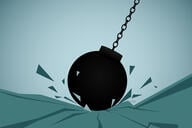You have /5 articles left.
Sign up for a free account or log in.
Last week I attended a workshop on “backwards” course design: planning courses by identifying the big ideas or main concepts that we want students to master, and then creating assignments by which students can demonstrate that they have mastered these concepts. As basic as this might sound, it’s a radical departure from the default method of syllabus construction in which we cram the books we’ve already ordered into the available weeks of the semester. None of this is new to me, but I need to be reminded every semester.
There’s a lot of resistance to changing the way we design our courses; after all, we all want to cover as much material as possible: it is all so important. Yet much evidence suggests that college students do not absorb all of the knowledge we present to them, and often graduate without grasping core concepts (such as basic scientific principles), even those in which they have received high marks. Recent work in the neuroscience of learning tells us that students can only process a limited amount of new information.
What do we most want our students to comprehend at the end of the semester? What do we want them to remember in five or even ten years? Recent political attacks on public education in Wisconsin have caused me view my students not just as our majors, or even graduates, but as future citizens and voters. I would like my students to understand the value of the humanities, not as a collection of texts, but as a practice of careful, rigorous reading and as an awareness of rhetorical style.
In order to accomplish this, I’ve decided that next semester I will decrease *slightly* the reading load in my novels course in order to add more assignments where students can hone their analytical skills. I will also include reflective papers where they’re asked to connect 18th and 19th century British literature to their own lives.
As I carefully consider how to link the main concepts of my disciplines to concrete assignments, I wonder how well I “align” my own values to the energy I invest every day. How many of the actions that I perform daily are directly linked to what’s most important to me, to who I want to become? How does one “backwards design” one’s own life? Not to sound morbid, but you start at the end.
I had the privilege of being with my father when he died and the image of that spare hospital room stays with me. At some point, hopefully not too soon, I will be in a similar room. Will I wish I had spoken more at department meetings, padded my resume, or stayed later at work? Probably not, unless these activities had been in pursuit of becoming the person I wanted to become. It’s hard to let go of the details, schedules and endless tasks. And of course many of these things must be done.
After my father died I packed his old white sneakers, a tattered paperback copy of Anna Karenina, his wire framed glasses, and some clothes into a brown paper bag the hospital provided. I felt sorry for myself carrying that bag out to the car -- for god’s sake, couldn’t the expensive cancer research hospital at least provide, I don’t know, nicer bags for the deceased person’s things? But my father hadn’t felt much self pity or rage or regret: he hadn’t become rich or famous or even happily married: he had spent his time becoming himself.

